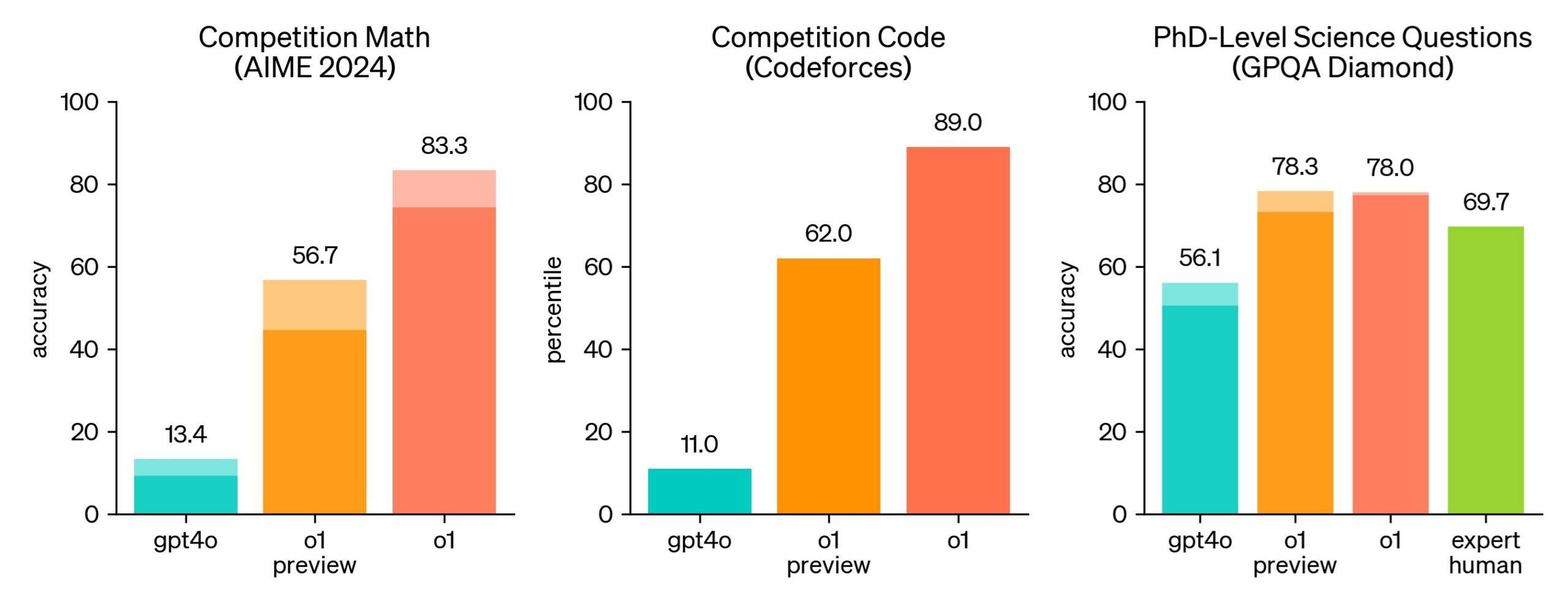OpenAI’s o1 Model Series: A New Era in Advanced AI Reasoning 🧠🚀

On September 12, 2024, OpenAI introduced its groundbreaking o1 model series, a massive leap forward in artificial intelligence focused on complex reasoning and problem-solving. This new model series is designed to take on the toughest challenges across domains like science, coding, and mathematics.
What sets the o1 series apart is its ability to think through problems before responding, just like humans do. Whether you’re a developer tackling complex code or a scientist working on cutting-edge research, the o1 model has been designed to help you solve problems more effectively.
The o1 Model Breakdown: Two Powerful Versions 🌟
The o1 series includes two versions:
- o1-preview: The most advanced model, designed for reasoning-heavy tasks like large-scale debugging, quantum physics problems, or intricate algorithm optimization.
- o1-mini: A more cost-efficient version that still brings the power of reasoning to lighter tasks, offering developers flexibility based on their needs.
Both models are equipped with reinforcement learning systems that allow them to produce chains of thought before they respond. This makes o1 more reliable for challenging tasks like debugging, code generation, and complex decision-making.
Achievements and Key Innovations 🔥
The o1 model isn’t just theory—it’s been rigorously tested and has demonstrated its power in real-world benchmarks. Here are some highlights:
- Ranked in the 89th percentile on competitive programming platforms like Codeforces.
- Placed among the top 500 students in the USA Math Olympiad (AIME), showing exceptional skill in solving high-school-level math problems.
- Achieved PhD-level proficiency in physics, biology, and chemistry on the GPQA benchmark, outperforming human experts in certain areas.
These accomplishments make the o1 model a game-changer for those working in STEM fields, providing cutting-edge AI capabilities that go beyond previous models.
How Does o1 Think? Chain-of-Thought Reasoning 🧠💬
The magic of the o1 series lies in its ability to think step by step. Instead of just spitting out answers, o1 constructs an internal chain of thought, allowing it to solve problems with greater accuracy and depth. Here’s why that matters:
- Improved Error Handling: By breaking problems into smaller steps, o1 can spot and fix mistakes on its own.
- Enhanced Problem-Solving: The model can rethink its strategy if one approach isn’t working, much like a human would.
- Better Decisions: This ability to reason through steps makes o1 excellent for decision-making in complex scenarios, whether in science, finance, or engineering.
Whether it’s cracking tough mathematical puzzles, solving ciphers, or navigating crossword puzzles, o1’s chain-of-thought reasoning significantly enhances its ability to solve complex, layered problems.
o1 vs GPT-4o: Performance Breakthroughs Across Key Benchmarks 📊
The o1 model significantly outperforms its predecessor, GPT-4o, across a variety of competitive benchmarks. Here’s how it stacks up:
- Coding Performance: o1-preview achieved higher Elo ratings on coding platforms like Codeforces, where it showed exceptional problem-solving skills in complex algorithmic challenges.
- STEM Mastery: In domains like Math, Physics, and Biology, o1 surpassed GPT-4o by scoring higher on rigorous benchmarks like GPQA Diamond.
- Human Preference: When tested on human-like reasoning in categories such as data analysis and math, o1-preview was overwhelmingly preferred over GPT-4o for its clear, logical approach to problem-solving.
This graph highlights the o1 model’s dramatic improvements across these benchmarks, pushing the limits of AI reasoning.
Safety-First Approach: Rigorous Evaluations and Jailbreak Resistance 🛡️
OpenAI has prioritized safety with the o1 series, making it one of the most robust models in terms of alignment and security:
- Jailbreak Resistance: In internal tests, o1-preview showed significantly higher resistance to jailbreak attempts compared to GPT-4o. This makes it safer for high-stakes uses, such as in healthcare or legal systems.
- Ethical Decision-Making: Thanks to its chain-of-thought reasoning, o1 is better equipped to align with human values and make sound, ethical decisions in real-world applications.
In terms of compliance on challenging prompts, o1-preview scored consistently higher than GPT-4o across a range of safety benchmarks, demonstrating its ability to handle edge cases and malicious queries.
Early Access: Developers, Get Ready! 🚀
If you’re eager to try out the o1 model, you’re in luck. It’s already available through OpenAI’s API and tools like GitHub Copilot. Developers can integrate this powerful reasoning model into their daily workflows, unlocking new capabilities in:
- Algorithm Optimization: Automating the process of improving code efficiency.
- Advanced Debugging: Solving issues in complex systems faster and with more accuracy.
- Scientific Research: Collaborating with o1 to tackle the most challenging problems in STEM fields.
Early adopters, such as ChatGPT Plus and Team users, have already begun using the o1 model, with broader access expected soon.
Conclusion: The Future of AI is Here, and It’s Thinking Smarter Than Ever 🏆
OpenAI’s o1 model series marks a massive leap forward in AI, pushing the boundaries of what AI can accomplish in reasoning, coding, science, and complex problem-solving. With its powerful chain-of-thought capabilities, enhanced safety, and proven performance across various benchmarks, o1 is poised to become a valuable tool for researchers, developers, and professionals in any industry.
The future of AI reasoning is bright, and o1 is leading the way! 🌟
Sources:
- OpenAI: “Learning to Reason with LLMs”
- “Evals and Chain-of-Thought Reasoning” (OpenAI, 2024)
